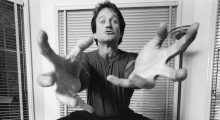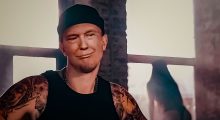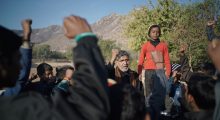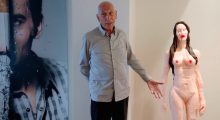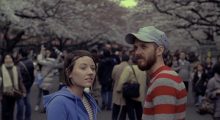6577 Results for “production”
-
Stop-Motion DP Tristan Oliver on Creating a Behind-the-Scenes VR Short for Wes Anderson’s Isle of Dogs

UK-based cinematographer Tristan Oliver has worked on stop-motion features, shorts, music videos and commercials for more than 20 years. Oliver served as DP on Fantastic Mr. Fox, Chicken Run and Wes Anderson’s forthcoming Isle of Dogs. For that last feature, Anderson also tapped Oliver to shoot a VR short on the making of the film, which enters theaters on March 23. Oliver spoke with Filmmaker about the cameras used on the film, translating Anderson’s aesthetic to stop-motion and the film as “an homage to Japanese cinema.” The short will screen as part of Sundance’s New Frontier program. Filmmaker: How and why […]
by Filmmaker Staff on Jan 18, 2018 -
“The Art of Silently Weeping While Pulling Focus at the Same Time”: DP Nick Higgins on Shooting Robin Williams: Come Inside My Head?

Following Water & Power: A California Heist in 2017 and Roman Polanski: Wanted and Desired in 2008, Marina Zenovich returns to Sundance for a third time with Robin Williams: Come Inside My Mind, her documentary on the late comedic maestro. Documentary DP Nick Higgins served as one of four cinematographers on the project. Higgins was the sole DP on O.J.: Made in America and has more than 50 cinematography credits to his name. Below, he shares his thoughts on lighting documentary subjects and why he prefers to shoot interviews with a single camera. Robin Williams: Come Inside My Mind screens four times at Sundance 2018. Filmmaker: […]
by Filmmaker Staff on Jan 18, 2018 -
“I Was Watching Russian TV More than My Entire Family in Russia”: Maxim Pozdorovkin and Matvey Kulakov on Editing Our New President

Maxim Pozdorovkin entered the documentary film world in 2013 with Pussy Riot: A Punk Prayer, a film that earned him top prizes at Sundance, Cinema Eye Honors and the British Independent Film Awards. He returned to Sundance in 2014 with The Notorious Mr. Bout. Now, he returns to the World Cinema Documentary Competition once again with Our New President, a doc on Russia’s propagandistic state-run news networks. Below, Pozdorovkin and co-editor Matvey Kulakov discuss how they crafted a feature film from such surreal archival footage. Filmmaker: How and why did you wind up being the editor of your film? What were the factors and attributes […]
by Filmmaker Staff on Jan 18, 2018 -
The Sundance Question: What Roles did Chaos and Order Play in Your Films?

Each year Filmmaker asks all the incoming feature directors at Sundance one question. (To see past years’ questions and responses, click here.) This year, our question involves an issue that might be appropriate given the dramas of the previous year: chaos and order. This year’s question: As you made your film during the increasingly chaotic backdrop of the last year, how did you as a filmmaker control, ignore, give in to or, conversely, perhaps creatively exploit the wild and unpredictable? What roles did chaos and order play in your films? “We Used Chaos to Clarify Our Senses and Capture True […]
by Filmmaker Staff on Jan 18, 2018 -
“We Went Where the Story Took Us”: Director Derek Doneen | Kailash

As you made your film during the increasingly chaotic backdrop of the last year, how did you as a filmmaker control, ignore, give in to or, conversely, perhaps creatively exploit the wild and unpredictable? What roles did chaos and order play in your films? Kailash is about a man who risks his life and the lives of his family and colleagues by breaking into factories to rescue children from slavery. Being that we chose to tell the story with vérité filmmaking — in realtime — the very nature of what we set out to shoot was inherently chaotic. We knew […]
by Filmmaker Staff on Jan 18, 2018 -
“Documentaries Are Less an Act of Creation and More an Act of Discovery”: DP Bob Richman on The Price of Everything

Brooklyn-born DP Bob Richman began his career as a production assistant for Albert and David Maysles. He’s since gone on to shoot some of the most widely seen documentaries of the past 20 years: An Inconvenient Truth, Waiting for ‘Superman’, the Paradise Lost trilogy and Metallica: Some Kind of Monster, to name a few. His latest feature, The Price of Everything, is a vérité doc on the puzzlingly astronomical price of fine art. Richman spoke with Filmmaker ahead of the film’s Sundance premiere about his preferred camera for vérité filmmaking, reuniting with director Nathaniel Kahn (My Architect) and the essential importance of a good […]
by Filmmaker Staff on Jan 18, 2018 -
25 Films We’re Excited about at the 2018 Sundance Film Festival

Sundance starts tomorrow, and just before the curtain raises we’re squeaking in with a list of films our correspondents — Vadim Rizov, Meredith Alloway and myself — are excited to see. I’m about to start packing, and colleagues from other magazines and companies are Facebooking their SARS-mask covered faces on their way to the influenza petri-dish of Park City. I could spin this intro out longer — quote Sundance festival director John Cooper on how this year’s festival is full of “alternative voices” — or perhaps left-turn into some metaphor or another, but I’ll just do what we do here […]
by Scott Macaulay on Jan 17, 2018 -
“If You Want That Melodramatic Shaft of Light, You’d Better Mean It”: DP Sam Levy on Shooting Lady Bird

There’s a tradition of young directors looking for inspiration in the bygone eras of their adolescence. For George Lucas in American Graffiti, it was the California car culture of the early ’60s. For Richard Linklater in Dazed and Confused, it was the Texas high school rituals of the ’70s. And for Greta Gerwig in Lady Bird, it’s Catholic school and the suburban doldrums of early-aughts Sacramento. Written and directed by Gerwig, Lady Bird follows the titular character (Saoirse Ronan) through her senior year of high school as she fights with her mom (Laurie Metcalf), pines for a philosophical dilettante from the […]
by Matt Mulcahey on Jan 17, 2018 -
No Poster is Better than an Amateur Poster: Five Takeaways from the IFP Narrative Lab

My first feature film, Kids Go Free to Fun Fun Time, is a drama/romance that takes place in three different countries, showing how a couple’s relationship evolves over the course of a decade. I have been working on this film for longer than I’d like to admit. I had little luck getting the funding or support needed to get the film done, but then I got accepted into the IFP Narrative Lab, and my world completely changed. To talk about everything I learned during the IFP Narrative Lab would take about 40 pages, so I’m going to try and boil it […]
by Ben Hicks on Jan 17, 2018 -
Time’s Up for the War on Stories

Christina Kallas, writer-director of multi-protagonist feature films 42 Seconds of Happiness and The Rainbow Experiment, which will have its world premiere at Slamdance on Saturday, January 20, takes a look at the current shift in storytelling and shares her thoughts on how to pursue a more inclusive cinema by redefining the past. A few years ago I wrote a series of articles including an eight-point plan of action for Ted Hope’s Truly Free Film blog, “How to Change the World (And Most Importantly, Why).” As one of my sources, I used the 2013 USC Annenberg Inclusion Initiative’s study, which is […]
by Christina Kallas on Jan 17, 2018

